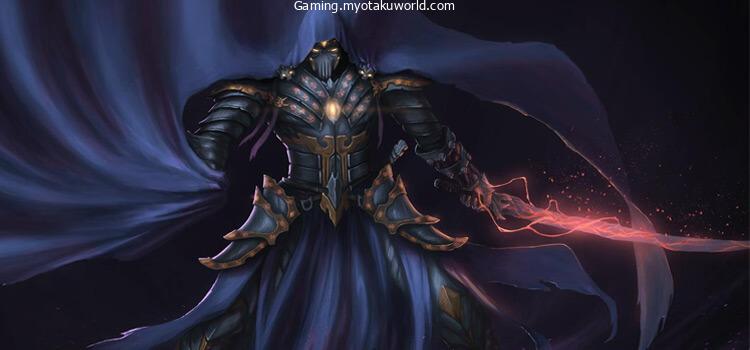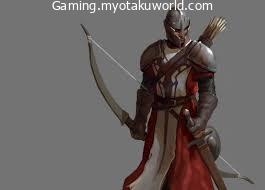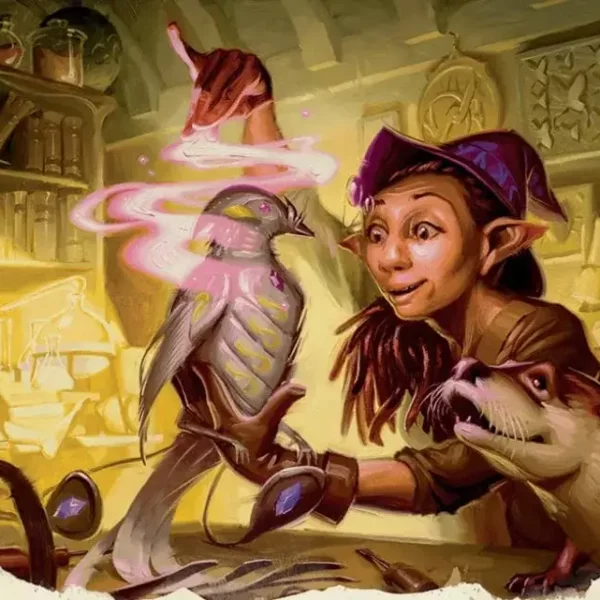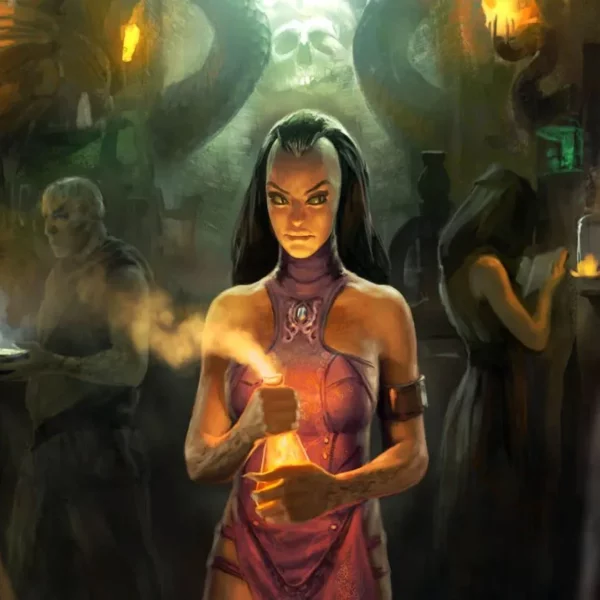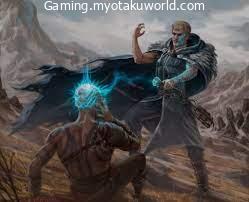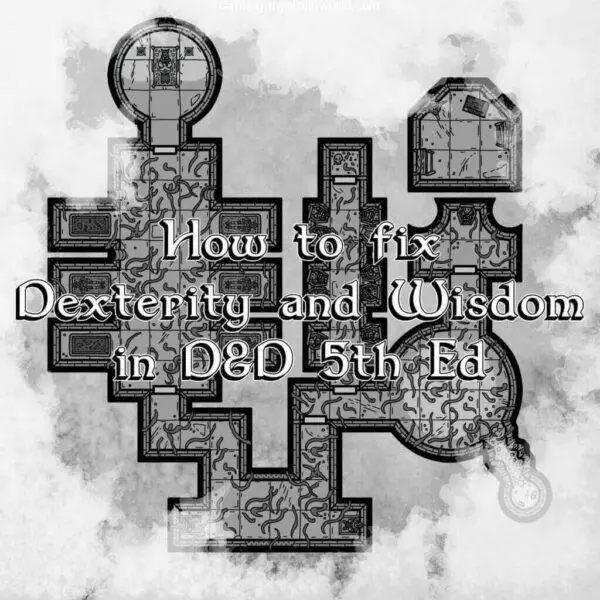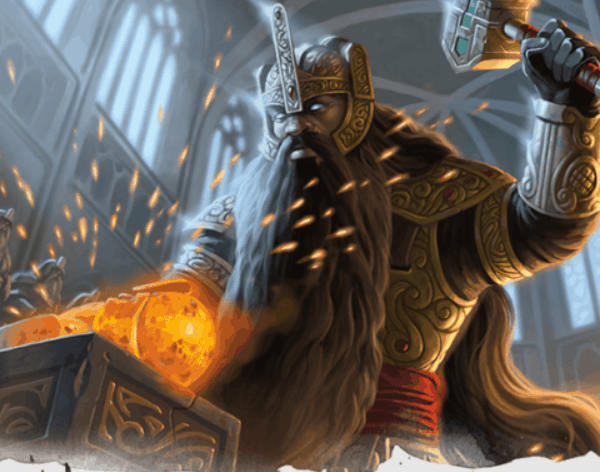Shadow Blade was one of the spells included in the 5th Edition in Xanathar’s Guide to Everything.
It’s a good spell, particularly for those who have taken some of the classes in spell casting.
Let’s get into the details and discover the ways it can be utilized to make fun, trouble, or whatever else you want to use it for.
What Does It Do?
Shadow Blade
School: Illusion
Level: 2
Casting Time: One Bonus Action
Range/Area: Self
Components: V, S
Duration: One Minute (Concentration)
The spell lets you create an elongated sword of shadow within your hand, and it can be considered a weapon that can use to strike. It’s a melee weapon that anyone who uses the spell can master.
It’s a skill that is refined, which means it can be attacked with strength or dexterity.
You can use it as an ax if you’d like as it will do better damage than the great sword when it takes an attack (2d8 psychic, plus the attack capability modifier).
This damage will increase the more you cast it in the higher-level slot, which can be up to 5d8 if you cast a 7th level or higher slot.
If you fall on it or throw it to attack, the spell goes away when you’re done with your turn. You can bring it back using the bonus action, as you’re still focused on the spell.
One of the benefits is the benefits you can gain when you make attacks in darkness. When you target objects in dim light or darkness, you have an advantage in your attack.
Then you weave threads of shadow and create an ethereal gloom sword within your palm. The magic sword will last until the spell is over.
It’s a standard melee weapon, with which you’re skilled. It inflicts 2d8 psychic damage per hit, and it has fine as well as light and thrown characteristics (range of 20-60).
Furthermore, if you employ the sword to attack an opponent dark or dim, you can make your attack roll using advantage.
If you lose your weapon or strike it away, it disappears at the end of your turn. Then, as long as the spell continues to work in effect, you can take additional action to cause the sword to return to your hand.
At higher levels. When you use this spell with the 3rd or 4th level slot, your damage is increased to 3d8. If you cast it with the 5th or 6th level slot, your damage is increased to 4d8. If you cast it using the spell slot that is 7th or more levels the damage increases to 5d8.
Who Gets Shadow Blade?
Warlocks, Sorcerers, and Wizards are granted the spell as part of their spell lists for classes.
Bards might be able to find it in the Magical Secrets, and Arcane Trickster Rogues and Eldritch Knight Fighters get it from the Wizard spell list.
Other classes can take advantage of it by multiclassing and adding at least 3 levels in Sorcerer, Warlock, or Wizard.
Uses For Shadow Blade
Shadow Blade is fairly simple.
You can make a sword that can be used for attacking.
It’s a great spell particularly for people with dark vision. We can also examine particular classes too.
1. Warlocks
Shadow Blade is an… intriguing spell that is suitable for warlocks. It is also a focused spell, which means it can compete with the hex as well as darkness when you have Devil’s Sight.
If you’re fortunate enough to have a Shadow Sorcerer in your party, they can use their darkness curse for you. Darkness will give you an advantage, and that is what makes the shadow blade rather useful.
Additionally, the shadow blade cannot be used either using the Pact of the Blade or the Hexblade’s Hex Warrior feature. Shadow Blade could be utilized in your off-hand in case you want to use two hands, but it’s not possible to make any of your Blade Pact invocations work with it.
It is an enjoyable melee choice for non-Pact Of The Blade warlocks. When you combine it with cantrip-like the green flame can make it more feasible.
But if you own the Eldritch blast and the Agonizing Blast invoker and Hex… it means you’ll typically have more damage-dealing options.
2. Eldritch Knight Fighters
Pros:
The spell is a very tactical choice for Eldritch Knights.
The spell won’t be available until you reach level 8, it’s An illusion-based spell therefore you must take it at the level where you can select one in any class.
Also, you don’t require an Intelligence score of high to apply the spell which is a huge advantage for you.
If you can access the spell, you’ll be able to create a sword that can do more damage than the greatsword. You can also use it in conjunction with a shield for additional AC.
When you have reached the 13th level, and you have a third-level spell slot you are now able to create the Shadow Blade that inflicts damage of 3d8 when hit.
The extra damage dice could truly add up to a combatant, particularly when you are using the Action Surge.
Cons:
It is important to focus on the magic.
This means that you are at a possibility of losing it if you inflict too excessive damage. It also tends to compete with spells such as haste as well as any other spells you’d like to focus on.
If you are able to locate a Flame Tongue or a different magical weapon that has lots of damaged dice you might choose to make use of it instead.
It frees your spell slots, allowing you to spell haste for further attacks, and also adds another benefit for defense.
If your game doesn’t include much magical equipment, Shadow blade is a viable alternative.
3. Arcane Trickster Rogues
Shadow Blade is fine for Arcane Tricksters. It causes some additional damage but doesn’t provide any additional attacks.
It’s just not as great as the Eldritch Knight.
The damage you can do depends heavily upon how you Sneak Attack. If you require an advantage for Sneak Attack and are in dark or dim lighting, a Shadow blade could be helpful.
The Versatile Trickster feature gives you another method to gain an advantage over the Mage Hand however it’s a bit more difficult to install.
It must be cast as an action. It’s an extra action to move the hand and is an additional bonus action to gain an advantage from it.
The Shadow Blade is simpler and doesn’t require your bonus action every time you turn.
It can be combined with the green flame blade or the booming blade to add some heat and thunder to the shadow blade’s psychic damage, on top of your Attack Sneak Attack.
4. Sorcerers
Sorcerers are usually very squishy. A spell that is intended for combat isn’t usually their style.
But, they can also have intriguing interactions using this spell. If you’re looking to fight this spell has some strong options.
If you have points of sorcery to burn and cast the shadow blade and then use the move to create the blasting blade cantrip two times using the Twinned Spell metamagic (Twinned Spell isn’t compatible with green flame blades, unfortunately).
If you wait until later it is possible to begin your turn by accelerating another explosive blade to make three strong melee attacks.
Pros:
In dim lighting or in darkness, particularly in the case of an elf with Elven accuracy, this could be an effective method.
With Your Twinned Spell and Quickened Spell metamagics, you can make up to 3 blades of cantrips per turn, which is not anything to get excited about.
At 17th level, your three attacks using Shadow Blade and the booming blade gives 5d8 psychic damage and 3d8 thunder damages to the target. They also deal an additional 4d8 thunder damage if they move.
The additional damage to thunder from the booming blade isn’t stacked on one person. However, it could be used to take down several opponents by threatening them with blasting damage. Combine it with the Mobile ability and you’ll be able to lock them down, and then run in complete freedom.
However, at the 17th level, it is possible to cast Meteor Swarm for 20d6 fire damage and 20d6 bludgeoning damage.
9th level spells provide plenty of choices. Shadow Blade and boom blade might not be the best option for every situation however if you’re looking for or require combat, it’s quite efficient.
Don’t be a victim to thunder or psychics.
Cons:
You’ll need a strong attack modifier even if you are able to easily get a triple advantage by using Elven Accuracy.
This means that you must be a sorcerer who has decent Strength or Dexterity. This implies that there is more need for high-quality stats or improvements in Ability Score.
This combination is designed for use against multiple adversaries. It is necessary an additional target available if you plan to make use of Twinned Spell, and if you don’t have another target within reach then you’re out of luck.
This strategy also burns points of sorcery.
If you’re looking to save your resources, you could limit yourself to twinning the booming blades because it’s less than less expensive than the Quickened Spell metamagic.
This brings the number of attacks using the booming blade down.
If you manage to find an Illusionist’s Bracers that you can use, you don’t have to use sorcery points for Quickened Spell. It’s more effective than you imagine, as the bracers are innately able to make a cantrip as an extra action.
This means that you can double your bonus with the booming blade to give you four attacks using the cantrip.
If you can purchase the bracers (from Guildmasters’ Guide to Ravnica) and come up with ways to protect your sorcerer from the enemy attack, you’ll become a formidable opponent in the field… for as long you’re not facing more than one adversary.
5. Wizards and Bards
Shadow Blade can be used here mostly to aid the Bladesinger wizard as well as Bard of the College of Swords Bard, and the College of Valor Bard.
Since the three subclasses receive the Extra Attack feature, the shadow blade is more effective than the three.
Different kinds of wizards and bards can still benefit from the spell, even if they’re confronted however it’s not as effective.
Pros:
There’s a high chance that each subclass will have an impressive Dexterity score, which means you don’t have to be concerned about boosting another score.
Bards of the sword tend to concentrate on melee attacks to make use of their impressive moves.
Because they can get these bonuses and for no cost at the higher level, using shadow blade can be a great way to increase their damage considerably.
It’s not as effective as high-level spells but it’s a tactic that allows them to take on some serious damage and also use the bonus spell to hand the Bardic Inspiration or to cast other bonus action spells such as healing words.
The Valor bard can create an attack with a weapon when casting the spell.
You can choose the ‘Blowing up the green flame’ blade to cause additional damage over the shadow blade. You can then make an attack with the shadow blade for a bonus attack.
You’ll need to pay two Magical Secrets to learn the Shadow blade and the Green flame blade which is quite costly.
Bladesinger’s Song of Victory feature lets players deal additional damage equivalent to the Intelligence multiplier whenever they use melee weapons attacks. This makes the shadow blade more attractive when they are at higher levels.
However, you’ll only be able to use two attacks. And those attacks will have to compete against the vast array of powerful spells that the wizard has access to.
Cons:
Every bard that wants the Shadow blade must multiclass or utilize some of their Magical Secrets for it. It can be a major demand when the game features Flameball as well as the counterspell.
Starting at 11th level the wizard is also granted the ability to access The Tenser’s Transformation. Bards are also able to access it via Magical Secrets.
Tenser’s transform produces approximately the same damage (an added 2d12 force in addition to the damage die of your weapon as opposed to. the flat 4d8 psychic when casting shadow blades at the 6th degree).
But like Shadow Blade, Tenser’s transformation does not need a shortage of light to benefit. It also grants the benefit of Extra Attack to wizards who don’t already have it and a couple of saving throw abilities as well as a significant amount of hit points temporary.
It’s at the expense of not being able to cast spells while focused upon the Transformation of Tenser however it’s an enjoyable spell for wizards that need to engage in melee.
In addition to a myriad of other amazing high-level spells, it’s difficult to get the shadow blade to keep up.
WHAT DOES SHADOW BLADE DO IN 5E?
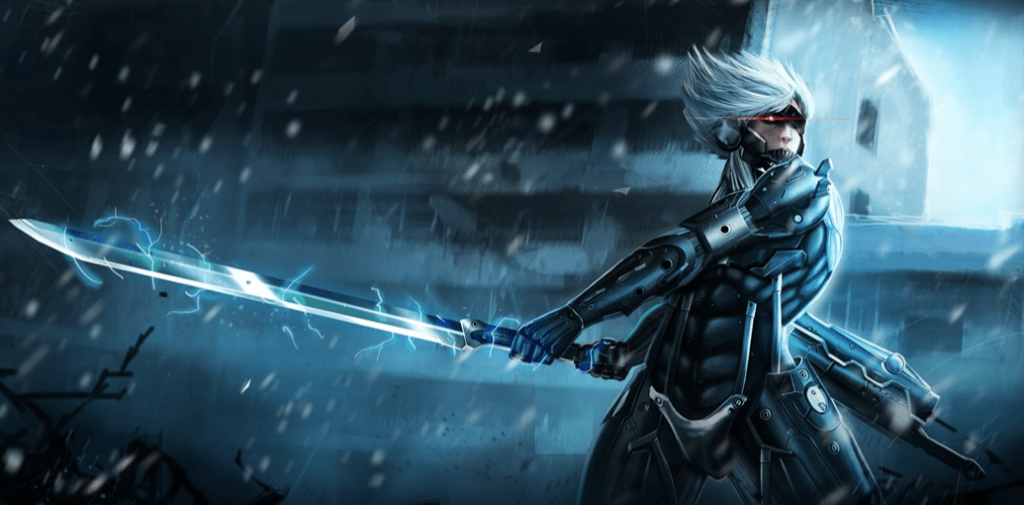
Shadow Blade fashions a mystical blade for you, which you are immediately skilled in using. Deals 2d8 (9 average) psychic damage when hit, plus whatever attack modifier (Strength or Dexterity) you use for the attack roll. If the target is hit, this damage is increased by one.
The weapon has the properties of finesse and lightness, and it can be thrown from a distance of 20 to 60 feet. In addition, when you use the sword to attack in low light or complete darkness, you have an advantage on attack rolls.
If you let go of the weapon during your turn, it will be removed from play at the end of your turn. You can use a bonus action to re-conjure the sword you have in your hand while the spell is still active (up to ten rounds of combat if your concentration holds out), but only if the spell is still active.
Lastly, the damage dealt by a Shadow Blade upcast can be increased to 3d8 at 3rd or 4th level, 4d8 at 5th or 6th level, and 5d8 at 7th level or higher. This can be done at any level.
Now for some of the more difficult rules…
Breaking Down The Spell’s Effect
Even though the spell’s description isn’t very long, the mechanics of Shadow Blade are quite complicated. This is due to the fact that it has an effect on the gameplay mechanism known as “attack.”
Magic Sword
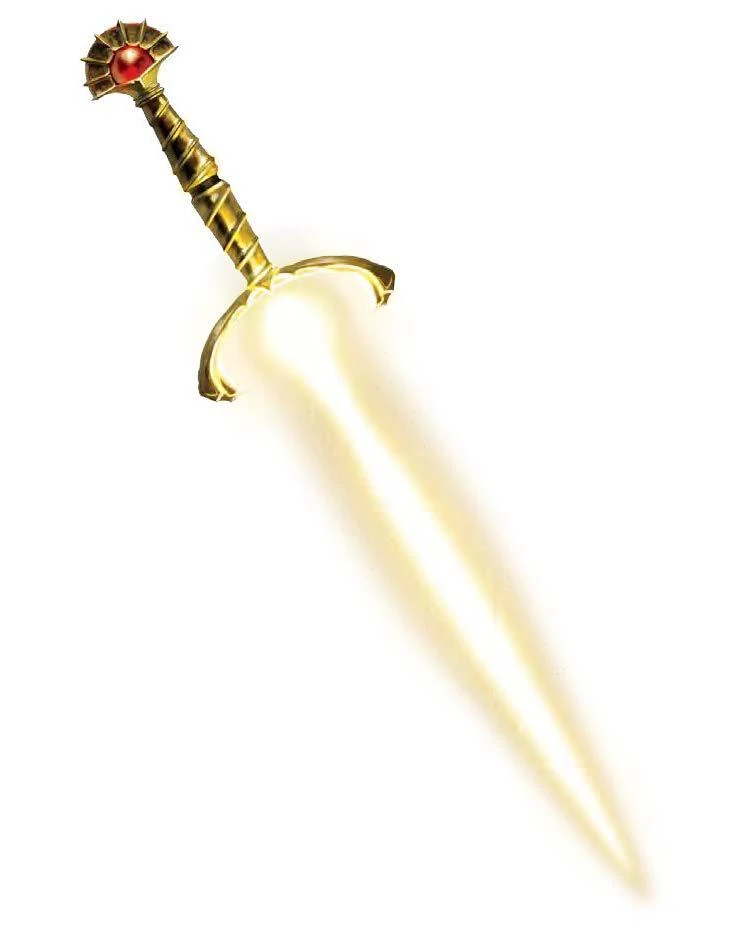
The Sword possesses mystical powers. Due to the psychic nature of the damage, the effect of this is relatively minor in terms of bypassing resistance. When put in context with other types of weapons, however, this becomes significantly more significant.
When something possesses magical properties, it cannot be harmed by methods that do not involve magic. On the other hand, a spell called “Dispel Magic” can be used in a reasonably short amount of time to destroy the weapon.
Weapon Type
You are skilled in the use of the weapon, which is a straightforward melee weapon. This means that whenever you make an attack, you add your proficiency modifier.
This is the case regardless of the shape that the weapon is made in. Keep in mind that even if you are an expert with the weapon, using it in melee combat requires you to attack with either strength or dexterity (depending on whether or not it has “finesse”).
Weapon Properties
The Shadow Blade possesses the following three qualities:
- Light is a property that when present grants the user the ability to make an attack with their off-hand using a bonus action. This attack is less powerful, and in the vast majority of situations, it won’t even come into play. Due to the fact that this property allows you to throw the weapon as a bonus action, it is important to keep in mind that you can do so. It is important to keep in mind that due to the introduction of One Dnd, two-weapon fighting may become more aggressive in the near future.
- Weapons that have the “Finesse” property allow the user to roll attack dice using their dexterity stat rather than their strength stat. Numerous builds that make use of this spell rely heavily on having this property. This trait’s significance is amplified when one considers that the vast majority of full-casters reduce their strength, but not their dexterity, because the latter affects their AC.
- This property, which has a score of 20 out of 60, is the cherry on top. The ability to throw the weapon confers a small amount of utility and versatility when confronted with difficult circumstances. It opens up options for casting for some classes that normally wouldn’t prioritize that particular spell. Characters who don’t want to engage in melee combat benefit from this property as well, as it increases their chance of surviving it.
Darkness And Advantage
When a martial class has the ability to make more than one attack, having advantage on attack rolls is one of the most powerful things it can have at its disposal. Having said that, the spell has a number of fascinating interactions with the Darkness.
For instance, if you were to cast the Darkness Spell, you would not be able to see anything within your own darkness unless you had an ability similar to Devil Sight. Nevertheless, if you were aware of the location of your foe during the attack, you would not be at a disadvantage but rather on equal footing. The long range of the thrown property provides an additional exciting interaction opportunity. In a normal situation, this attack would put you at a disadvantage, but if you make it while it is nighttime, it will have no effect.
Similar to these, there are a lot of interactions that change depending on whether or not you attack in the darkness. This is due to the fact that a single advantage can nullify a number of disadvantages, and vice versa. If the attack takes place in the dark, even if you are prone, restrained, blinded, or poisoned, Shadow Blade will negate all of those effects.
After all of this has been said, it is important to keep in mind that the races that possess darkvision will have the best chance of truly gaining an advantage.
Damage
When I discuss the amount of damage that something in the game does, I tend to get a little bit mathematical and detailed. This is the most effective method for contrasting with the various other game resources. When it comes to the Shadow Blade, the 2d8 damage it deals translates to an average of 9 damage per attack. If you were only to make one strike when you cast the spell, the outcome would be pitiful. On average, Scorching Ray deals 21 fire damage while using the same spell slot as other similar spells.
However, Shadow Blade is not just a spell; it also functions as a weapon, and when compared to the game’s other standard weapons, it deals the most damage of any of them. The polearms are the most notable weapons included in the starting equipment, and each of them can deal a maximum of 2d6 damage.
When we think about abilities that are activated by weapon attacks, this is extremely important to keep in mind. The most notable of these is the Extra Attack that certain characters possess, which doubles the amount of damage they deal. If you have a character that is capable of making two attacks per turn, then by the end of the second turn, that character will have done an average of 36 damage.
Another essential aspect to consider is the fact that you can also use Opportunity Attacks with Shadow Blade. Depending on the circumstance, the significance of this minuscule detail could not be overstated. The addition of a new attack that deals this much damage is no laughing matter.
Damage Type
One of the most effective varieties of damage in the game is psychic damage. The number of monsters that have resistance to that damage is extremely low. Despite this, there are a significant number of creatures, particularly constructs, that are immune to it. This is an excellent strategy for dealing with organic dangers, but it is not nearly as effective for dealing with mechanical or psionic threats.
It is important to keep in mind that the blade would not be able to cause damage to most things most of the time, despite the fact that the damage type is fantastic for combat. On the other hand, this could be rethought of as a spell that deals with shadowy substance or with materialized gloom. More will be said about that at a later time.
Dissipation And Reappearance
This is an important part of the spell for two reasons. First, when you let go of the weapon at the end of your turn, it goes away. This means you can’t throw the weapon on your first attack.
Instead, you have to use a bonus action and throw the weapon again. By the rules, if you want to use your bonus action to bring the weapon back to your hand, it needs to go away.
Second, since the weapon comes back as a bonus action, it’s a good way to attack from a distance with almost no risk, while still getting the spell’s high damage and type.
Spell Slot Progression
The spell doesn’t go in a normal order. If it can grow to 3d8 with only one spell slot, it is the best spell to cast at 3rd level. Full spellcasters will get these spell slots at level 5, while others will have to wait longer.
So, even if you only cast the spell once, it will have a big effect. Still, it’s slowed down because it might be too strong if we count it as an attack.
IS SHADOW BLADE 5E A GOOD SPELL?
In Dungeons & Dragons 5th Edition, the spell Shadow Blade is useful—but only for certain character builds. Because immunity to psychic damage is so uncommon (only 21 out of 818 creatures in the official sourcebooks have it) and resistance to it is even rarer (19 creatures), it can be relied upon.
It is fairly reliable to have advantage on your attacks as well, as darkness and dim light are also very common in many DnD adventure settings (just make sure to bug your DM about the room’s lighting every time).
The finesse and thrown properties are great added properties that allow you to use Shadow Blade from a limited range if necessary and use it with Dexterity instead of Strength. This is something that the majority of half-casters really appreciate because it means that they only need to invest in two ability scores.
In light of this, Shadow Blade is not a particularly good choice for full-casters who have low ACs and few reasons to get close enough to enemies to engage in melee combat. It is also important to point out that the Hexblade Warlock is not a fan of the Shadow Blade. This is due to the fact that they are unable to use it as either their Pact weapon or their Hex Warrior weapon, which makes it a lot less useful for them.
FAQs
Can you dual-wield with Shadow Blade?
Yes, you can. You can use a bonus action to make an additional attack with another light weapon if you have the Shadow Blade equipped because it possesses the light property. In light of this, you won’t be able to use two shadow blades at once. You are only allowed one cast at a time because it requires a lot of concentration.
IS SHADOW BLADE + DARKNESS GOOD?
To a limited extent. Because concentration is required to cast both spells, it is impossible for a single person to combine their effects. The fact that a character with normal darkvision is unable to see through magical darkness means that the advantage you gain from the spell is nullified by the blinded condition they are in. In spite of this, it is possible to circumvent this limitation by employing the warlock’s devil sight or the blind fighting style. Having said that, the advantage that is guaranteed by shadow blade is rendered meaningless if the creature is already blinded as a result of the darkness spell.
WHAT FEATS ARE GOOD FOR SHADOW BLADE?
Any feat that is applicable to a dagger would also apply to a shadow blade, as it functions similarly to a dagger but deals significantly more damage. The kinds of feats that are typically beneficial for martial artists are also beneficial for you. The dual wielder, mobile, sentinel, and defensive duelist are some examples of such classes. Warcaster and resilient are two more excellent choices that will help you keep your concentration (constitution).
